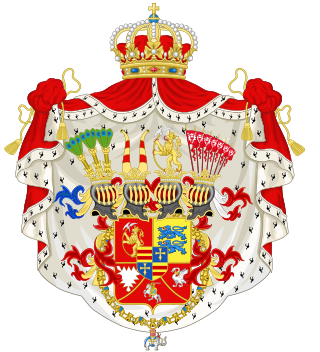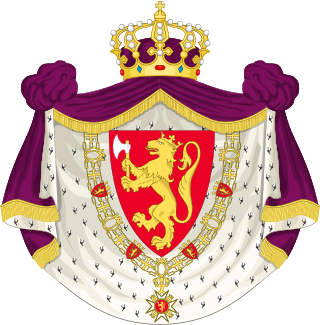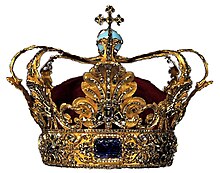
Christian V was king of Denmark and Norway from 1670 until his death in 1699.

The royal arms of England are the arms first adopted in a fixed form at the start of the age of heraldry as personal arms by the Plantagenet kings who ruled England from 1154. In the popular mind they have come to symbolise the nation of England, although according to heraldic usage nations do not bear arms, only persons and corporations do. The blazon of the arms of Plantagenet is: Gules, three lions passant guardant in pale or armed and langued azure, signifying three identical gold lions with blue tongues and claws, walking past but facing the observer, arranged in a column on a red background. Although the tincture azure of tongue and claws is not cited in many blazons, they are historically a distinguishing feature of the arms of England. This coat, designed in the High Middle Ages, has been variously combined with those of the Kings of France, Scotland, a symbol of Ireland, the House of Nassau and the Kingdom of Hanover, according to dynastic and other political changes occurring in England, but has not altered since it took a fixed form in the reign of Richard I of England (1189–1199), the second Plantagenet king.

Three Crowns is the national emblem of Sweden, present in the coat of arms of Sweden, and composed of three yellow or gilded coronets ordered two above and one below, placed on a blue background. Similar designs are found on a number of other coats of arms or flags.

The Iron Crown is a relic and may be one of the oldest royal insignia of Christendom. It was made in the Early Middle Ages, consisting of a circlet of gold and jewels fitted around a central silver band, which tradition held to be made of iron beaten out of a nail of the True Cross. In the medieval Kingdom of Italy, the crown came to be seen as a relic from the Kingdom of the Lombards and was used as regalia for the coronation of the Holy Roman Emperors as kings of Italy. It is kept in the Duomo of Monza.

St Edward's Crown is the centrepiece of the Crown Jewels of the United Kingdom. Named after Saint Edward the Confessor, versions of it have traditionally been used to crown English and British monarchs at their coronations since the 13th century.

The House of Glücksburg, shortened from House of Schleswig-Holstein-Sonderburg-Glücksburg, is a collateral branch of the German House of Oldenburg, members of which have reigned at various times in Denmark, Norway, Sweden, Iceland, several northern German states, Greece, and the United Kingdom.

The House of Oldenburg is a German dynasty with links to Denmark since the 15th century. It has had branches that rule or have ruled in Denmark, Iceland, Greece, Norway, Russia, Sweden, the United Kingdom, Schleswig, Holstein, and Oldenburg. The current Queen of Denmark, King of Norway and King of the United Kingdom are all patrilineal descendants of the Glücksburg branch of this house.

Rosenborg Castle is a renaissance castle located in Copenhagen, Denmark. The castle was originally built as a country summerhouse in 1606 and is an example of Christian IV's many architectural projects. It was built in the Dutch Renaissance style, typical of Danish buildings during this period, and has been expanded several times, finally evolving into its present condition by the year 1624. Architects Bertel Lange and Hans van Steenwinckel the Younger are associated with the structural planning of the castle.

Amalienborg is the official residence for the Danish royal family, and is located in Copenhagen, Denmark. Queen Margrethe ll resides in the palace during winter and autumn. It consists of four identical classical palace façades with rococo interiors around an octagonal courtyard ; in the centre of the square is a monumental equestrian statue of Amalienborg's founder, King Frederick V.

The Order of the Elephant is a Danish order of chivalry and is Denmark's highest-ranked honour. It has origins in the 15th century, but has officially existed since 1693, and since the establishment of constitutional monarchy in 1849, is now almost exclusively used to honour royalty and heads of state.

The Danish royal family is the dynastic family of the monarch. All members of the Danish royal family except Queen Margrethe II hold the title of Prince/Princess of Denmark Or Count/Countess of Monpezat children of the monarch and of the heir apparent are accorded the style of His/Her Royal Highness, while other members of the dynasty are addressed as His/Her Highness. The Queen is styled Her Majesty.

Danish Crown Regalia are the symbols of the Danish monarchy. They consist of three crowns, a Sceptre, Globus cruciger, the Sword of state and an Ampulla . The Danish Royal Regalia are kept in the treasury at Rosenborg Castle. The oldest of these is Christian III's sword of state from 1551. They further include King Christian IV's diamond; pearl- and gold-embroidered saddles; objects carved from ivory and rock-crystal; lapidary pieces of precious stones, and brooches in the form of fantastic animals.

The coat of arms of Norway is the arms of dominion of king Harald V of Norway, and as such represents both the monarch and the kingdom. It depicts a standing golden lion on a red background, bearing a golden crown and axe with silver blade.

The coat of arms of the Slovak Republic consists of a red (gules) shield, in early Gothic style, charged with a silver (argent) double cross standing on the middle peak of a dark blue mountain consisting of three peaks. Extremities of the cross are amplified, and its ends are concaved. The double cross is a symbol of its Christian faith and the hills represent three symbolic mountain ranges: Tatra, Fatra, and Matra.

The coat of arms of Denmark has a lesser and a greater version.

The Norwegian monarch is the head of state of Norway, which is a constitutional and hereditary monarchy with a parliamentary system. The Norwegian monarchy can trace its line back to the reign of Harald Fairhair and the previous petty kingdoms which were united to form Norway; it has been in unions with both Sweden and Denmark for long periods.

Rosenborg Castle Gardens is the oldest and most visited park in central Copenhagen, Denmark. Established in the early 17th century as the private gardens of King Christian IV's Rosenborg Castle, the park also contains several other historical buildings, including Rosenborg Barracks, home to the Royal Guards, as well as a high number of statues and monuments. The park also holds art exhibitions and other events such as concerts in the summer.

Paul Kurtz came to Denmark from Germany in 1655. He made silver and gold items for Frederik III and was mentioned in 1659 as "the King's goldsmith".

The Coronation Chair of Denmark is the chair formerly used in the coronation of the Danish monarch.

The Crown of Christian IV, created for the coronation of Christian IV of Denmark-Norway, on 29 August 1596, is the older of the two surviving crowns of Denmark. Only used for one more coronation, that of his son, Frederick III, in 1648, it is together with the other Danish crown jewels now on display in the Royal Danish Treasury at Rosenborg Castle.




















